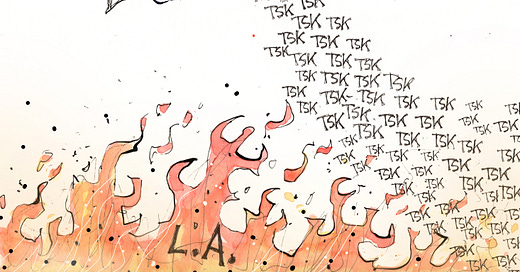Cartoon by Pulitzer-winning Matt Davies for Newsday. · Sree’s newsletter is produced with Zach Peterson with the Digimentors Tech Tip from Robert S. Anthony. · Run an ad with us; here’s our sponsorship kit.
***
“Climate refugees” evokes images of South Pacific Islanders whose isles have been consumed by the ocean, or movie characters in a faraway future. Not Los Angelenos, North Carolinians, and Floridians in 2025. But this is exactly what’s happening.
USA Today—not Greenpeace or the Sierra Club—wrote the following:
In many cases, people who can't or don't want to rebuild will become part of the growing number of climate refugees forced to relocate following natural disasters supercharged by climate change.
The evidence is piling up that huge population centers in America are more susceptible to all kinds of natural disasters than ever before—until next year when the goalposts move again. Insurance companies seem to largely agree with this assessment, and the major ones project things to only get worse over the short- and medium-term.
Here’s a snippet of State Farm’s statement on ending property and casualty insurance in California in May of 2023:
State Farm General Insurance Company made this decision due to historic increases in construction costs outpacing inflation, rapidly growing catastrophe exposure, and a challenging reinsurance market.
There are plenty more examples of this, but the most interesting part is how blasé insurance companies are about it all. This Vox piece, written in the aftermath of hurricanes Helene and Milton, is an excellent primer on the whole thing. The part that stood out to me was that figuring in climate-related risk was something insurance companies consider old hat—they have been doing it for decades.
From the piece, quoting Rob Newbold, a risk consultant:
“I don’t want to try to suggest that climate change isn’t happening. The climate is changing. But climate itself has been a factor in insurance losses forever,” Newbold said. “We’re seeing this overall level of insured losses [rising], but from our perspective, the industry should not be surprised by this because the tools exist to quantify that risk.”
The insurance giants don’t need fancy new super computer-based models. They’ve been hedging against climate change for as long as there’s been insurance, and disaster payouts are a built-in part of doing business—a business that is turning record profits.
As these profits pour in, people who cannot afford to pack and move with their assets wiped out are now packing and moving to start over. For so long, we’ve taken a very uniquely selfish view of migration brought on by our changing climate. Farmers in Sub-Saharan Africa have been driven to cities due to extreme rain patterns. Rising sea levels are driving tens of millions of people from low-lying coastal areas. Extreme flooding in Brazil has forced the migration of hundreds of thousands of people. That number is closer to 10 million in Pakistan, according to the IOM UN Immigration’s Environmental Migration Portal. Prolonged droughts in Central America — the list goes on and on and on, and it will continue to do so.
America has, for the most part, ignored these events abroad. Although the incoming Trump administration will almost certainly exacerbate our effect on the natural world, the natural world is more than capable of humbling even the most strident of MAGA believers.
Here it is in plain terms from Columbia Magazine:
One thing that climate scientists know for sure is that America’s natural environment will be utterly transformed by mid-century, with profound implications for people’s health, safety, and quality of life. This will be true even under optimistic climate scenarios, such as if the world’s largest economies accelerate their transition to renewable-energy systems and hold average global temperatures to five or six degrees Fahrenheit above preindustrial levels. Scientists now know with a fair degree of certainty, for example, that sea levels will rise one to two feet along the Gulf Coast and Eastern Seaboard by 2050, putting millions of homes at risk for regular flooding.
A 2021 World Bank report estimated that more than 200 million people would be forced to migrate within their own countries by 2050. The numbers are dire:
Climate change is a powerful driver of internal migration because of its impacts on people’s livelihoods and loss of livability in highly exposed locations. By 2050, Sub-Saharan Africa could see as many as 86 million internal climate migrants; East Asia and the Pacific, 49 million; South Asia, 40 million; North Africa, 19 million; Latin America, 17 million; and Eastern Europe and Central Asia, 5 million.
It is past time to add the U.S. to the list and start keeping track. According to data analytics firm First Street, the number of internal, climate-related migrants was more than 3.2 million as of December 2023—a number that has surely risen in the meantime. Here’s the full report and here’s a write-up from USA Today.
More people are more vulnerable to natural disasters every day, and I don’t see a political system in America willing to make even the least-impactful of decisions, let alone taking real, meaningful action, to mitigate the effects on the communities lost, and those that are risk being overwhelmed.
The fires in Los Angeles are not even a harbinger of things to come. They are a just another symptom of the increasingly-dire situation that we are in right now. There are, of course, vast partisan divides on how we, as a country, attempt to address our severe impact on the world. But, like so many things, there is actually agreement on the broad strokes. This is from Pew Research Center:
In reality, we have to start taking action yesterday. This has been the case for several decades, and the horizon is foggy at best. We can rest assured that the coming four years of a GOP-led government will do its worst to get the U.S. out of as many climate-related entanglements as it can, and that will start at home.
We simply cannot let this happen.
— Sree | Twitter | Bluesky | IG | LinkedIn | FB | YouTube / Threads | Spread | TikTok
💵 In December, I made the case for funding new media outlets. Am cooking up some ideas and looking for collaborators and partners. Ping me: sree.sreenivasan1@gmail.com.
🗞️ #NYTReadalong: Sundays 8:30-10 am ET, Neil Parekh and I read a newspaper out loud on social media with a fab guest. This week we have media personality and podcast host CHETACHI EGWU, aka Dr TACHI, live from Miami. Watch the video here; and several years of archives here. Sponsored by MuckRack. Want to be — or suggest — a guest? neil@digimentors.group.
TECH TIP | Fire Safety: Being Prepared is the First Step
By Robert S. Anthony
Each week, veteran tech journalist Bob Anthony shares a tech tip you don’t want to miss. Follow him @newyorkbob.
It’s rare when the mood at the annual CES technology show in Las Vegas darkens, but that was the case this month as news of the destructive California wildfires started to spread. Some Los Angeles-area residents abruptly cut short their attendance at the show to return to homes they weren’t sure would still be there.
While fire safety wasn’t a major topic at CES 2025, there were many products seen at the show that could at help people respond swiftly to fire dangers and keep safe.
Battery-powered weather radios—units that turn on and sound a loud alarm when they receive a weather radio alert signal—can be godsends when cell phone service goes down. In addition to hurricane, blizzard and other weather issues, NOAA Weather Radio Alerts are also sent out for non-weather emergencies such as earthquakes, civil emergencies and fires.
Among the many radios shown at the Sangean booth at CES was its AM/FM Weather Alert Pocket Radio Model DT-800 FCC, which works as a standard AM/FM radio and also picks up the seven NOAA Weather Radio Alert frequencies, which range between 162.40 and 162.55 MHz. The unit, which runs on two rechargeable AA batteries, can store up to 45 AM, FM and weather station frequencies.
If cell phone connectivity is still present, the Scanner Radio app from GordonEdwards.net provides quick access to police and fire department frequencies. Users can search for their local authorities and bookmark them for later use.
Kidde, which makes numerous fire safety products, and Ring, famous for its web-connected doorbell cameras, announced at CES 2025 a new collaboration resulting in Kidde-brand smoke and smoke/carbon monoxide detectors that can be monitored remotely with the Ring app.
Users can get alerts on the Ring app if problems are detected—an obvious benefit when they are away from home—and can upgrade to a $5 monthly, 24-hour professional monitoring service in which agents can contact authorities or user-provided contacts if problems arise.
According to Kidde, the new Smart Smoke ($54.97) and Smart Smoke + Carbon Monoxide ($74.97) alarms, available in April, provide smoke sensing technology 25 per cent faster and three times more precise than previous Kidde units, thus reducing the number of false alarms from cooking.
The availability of portable backup power can be essential when the power grid goes down. The new EcoFlow DELTA 3 Plus Portable Power Station can be charged quickly yet still provide hours of backup power. According to EcoFlow, a 30-minute charge from an AC outlet provides enough stored power to keep a refrigerator operating for five hours.
The IP65 weather-resistant power station works with the EcoFlow app, which not only monitors the status of the $649 unit’s 1,024 watt-hour LFP (lithium iron phosphate) battery, but also receives alerts of potential power outages in the user’s area. The unit, which can handle AC devices drawing as much as 1,800 watts, provides six AC outlets, two USB-A ports, two USB-C ports and a 12.6-volt car outlet.
No, nature can never be defeated, but today’s tech can at least help you prepare for the worst.
Did we miss anything? Make a mistake? Do you have an idea for anything we’re up to? Let’s collaborate! sree@sree.net and please connect w/ me: Twitter | Bluesky | IG | LinkedIn | FB | YouTube / Threads | Spread | TikTok








My favorite quote, "Although the incoming Trump administration will almost certainly exacerbate our effect on the natural world, the natural world is more than capable of humbling even the most strident of MAGA believers."
😪